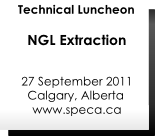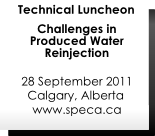| can't see the pictures? view it in your browser here. | ||||||||||||||||||||||||
|
||||||||||||||||||||||||
 Miscible flooding is a type of secondary recovery, where natural gas is injected into reservoirs to increase oil recovery. A flood is called “miscible” if the injectants will mix with oil in the pool. Proven Reserves’ many years of experience in flooding can help oil companies indentify ways to make more oil and gas faster. Several factors impact the miscibility of injectants including the composition of the natural gas, the pressure of the reservoir and the API gravity of the oil in the pool. A small fraction of the pools in Alberta have gas injected in them. Less than 1% of the oil pools in Alberta are under miscible flooded. Less than 5% of the floods in Alberta are miscible. A snall fraction of Alberta pools are under miscible flood.
Sizable oil pools surveyed were over 170 e3m3(1 MMBO). Pools under this size are not usually considered large enough to flood. The reason there are very few miscible floods is because the injectant is much more expensive than water. However, water and oil are not miscible therefore oil recovery is much lower in a water flood. Miscible flooding is not new. The first miscible floods started in the 1960s. Cost of injectant In the past, oil companies have not used this technology because the injectants used in a miscible flood are far more costly than produced water. However, today’s gas prices are far below parity with oil. Some gas wells are shut-in awaiting a higher commodity price environment. Counting the total cost per barrel of recovered oil, the cost of miscible flooding can be much cheaper than the cost of water injection in some pools. The small incremental cost of gas as an injectant is dwarfed by the improved recovery that comes from miscible flooding. Famous miscible floods The oil pools on the Alaska North Slope have been miscibly flooded since the start of production. Because there is no market for natural gas on the Beaufort Sea, using natural gas as an injectant was the perfect solution for this area. Even so, a natural gas pipeline was under discussion several years ago, to transport injectant gas recovered from the oil reservoirs there. Similarly, Keg River pools in the Rainbow Lake Area have received gas injection since the 1960s because there was no gas pipeline to take methane from the area. Recovery factors Miscible flooding has the ability to raise recovery factors from 20% up to 80% of the oil in place. Even the conservative ERCB predicts recovery of the Rainbow Keg River floods at 60%. Pools under primary recovery in Rainbow typically recover 20% and water floods recover 30%. Miscible recoveries are so much higher than primary due to viscosity reduction. Under the right conditions, gas injectant mixes with the native oil in the pool. The resulting liquid is thinner than the original oil. This allows it to move out of the reservoir easier leaving less behind. When the oil is produced, it gives up the natural gas used to thin it. The gas is recovered and can be sold or recycled back into the reservoir again. Granger J. Low |
|
|
 Oil and water in a rock pore are usually immiscible. One of them is usually attracted more to the rock than the other. This phase is called the wetting phase. Sandstones are usually water wet. Carbonates can be oil wet or more often have an intermediate wettability. Since one of the phases sticks to the rock, the other must slip past it to flow. If a rock is oil wet, reducing the amount of oil stuck in the pores is difficult. If a rock is water wet, oil may still get stuck in a pore when the pore throat is completely blocked by water. Most, but not all, tertiary recovery methods focus on reducing the oil trapped due to wettability issues. |


Mark is a completions engineer. Mark’s bottom-line is always connected with his drilling schedule, but accurately predicting when applications will be approved, when rigs can be booked, and when production can begin always seemed like a tricky gamble. Mark often felt frustrated and helpless in the face of constantly shifting timelines. Then Mark discovered AppIntel, which gave him monthly ERCB submission and approval details and statistics, allowing him to more efficiently gauge his projects’ timelines. With newfound clairvoyance, Mark is able to more accurately map out project timelines and keep his wells on schedule. Ensure You can Drill on Schedule! www.proven-reserves.com/appintel.php |
|
|
|









